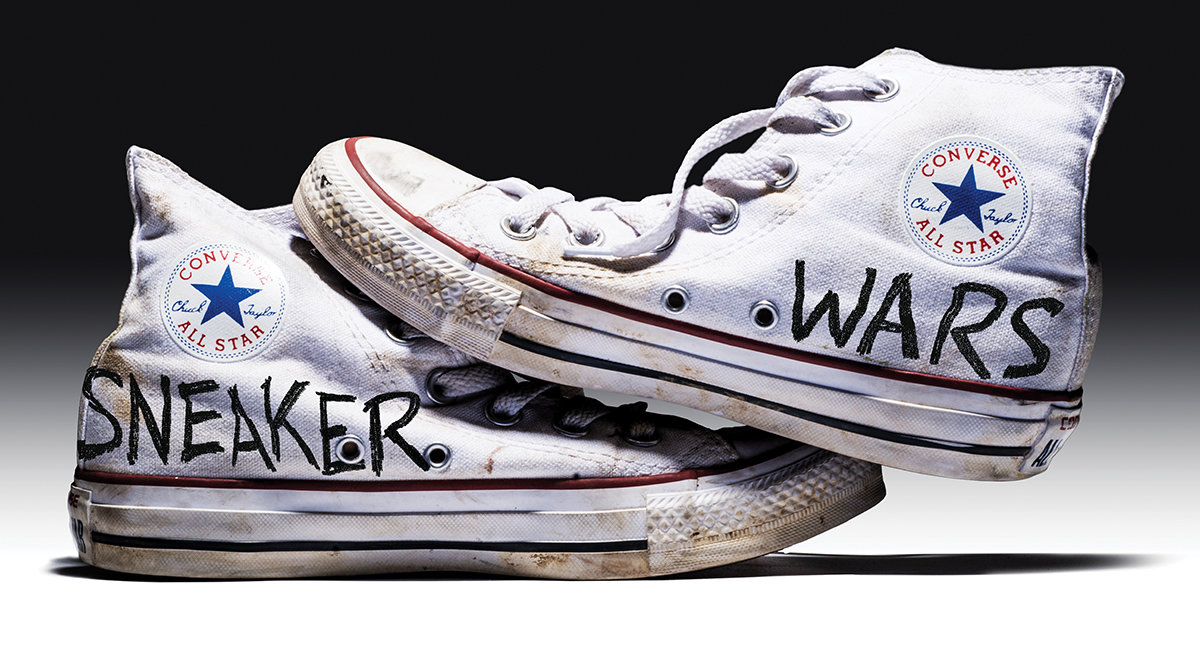Sneaker Wars: Converse vs. New Balance

Photograph by Toan Trinh
The last thing anyone at Converse’s North Andover headquarters thought they needed was a new CEO. Relegated to the clearance bin of the sneaker industry since the 1980s, the 107-year-old company had bounced back from bankruptcy and in 2010 was coming off a record year, with nearly $1 billion in sales. So in 2011, when parent company Nike installed its rising star Jim Calhoun—son of legendary University of Connecticut basketball coach Jim Calhoun Sr.—employees were quick to remind him that they’d just received the largest bonuses of their careers. The message was clear: We’ve got a good thing here. Don’t screw it up.
Yet Calhoun saw a company that was still in peril. Employees—from sales clerks to vice presidents—were insecure, apologetic, and suffering from an inferiority complex. Nike, a once-fledgling brand that had bought the bankrupt Converse in 2003 for a song, was making Calhoun’s new colleagues feel “how Ted Kennedy felt about having Robert and John as his older brothers,” Calhoun says. Nike executives rarely visited Converse’s modest headquarters, forcing Calhoun to travel roughly once a month to the mother ship in Beaverton, Oregon, for an exhaustive round robin of corporate sermons. “Every game,” he recalls, “was an away game.”
But that was far from Converse’s biggest problem. An existential threat lurked in plain sight. A century into its storied history, it was clear that Converse had only one sneaker to show for: The iconic Chuck Taylor All Star accounted for more than 85 percent of the company’s revenue. The product line was ancient and had barely been updated since the Great Depression. In that time, competitors had unleashed top-selling, space-age innovations, including Reebok’s Pump, in 1989; Adidas’s supportive Feet You Wear technology, in 1996; and Nike’s very own Lunarlon foam cushioning, in 2008, designed to mimic the way astronauts jump from the moon “as if on marshmallows.” Meanwhile, market research showed Converse’s canvas shoes hurt people’s feet, and customers complained that the soles were about as supportive as stale sub rolls. On top of it all, Calhoun saw how dozens of big-name brands had for years been selling sneakers that looked nearly identical to the Chuck Taylor. It made Chucks the most imitated shoe in the world—and also cut deep into Converse’s potential profits.
Each morning on his drive to work from his home in Wellesley, Calhoun passed New Balance’s sprawling new headquarters along the Mass. Pike in Brighton. The campus, which is still being developed, will feature a sports complex, two residential towers, an office building, and its own MBTA commuter-rail station. The shining behemoth was an immutable reminder of the fierce sneaker competition not just here in Massachusetts—which Calhoun has dubbed “Sneaker Town, USA,” where the hometown teams include Saucony, Reebok, and Puma North America—but also around the globe.
Calhoun looked at all of this and knew he had to make a change. Converse needed a modern headquarters of its own, this time in Boston. It needed a new shoe to win fresh customers and bring back people who had abandoned Chucks for cheaper, more comfortable knockoffs. Converse needed youth; it needed new life. And it needed to get aggressive, not only to remain a player in the $54-billion-a-year global sneaker game, but also to smother the competition.
So last October, Calhoun turned federal court into Converse’s personal Thunderdome—suing 31 companies that he believed were selling copycat Chucks, from Ralph Lauren to Kmart. He even went after the largest retail titan on the planet, Walmart. Rather than heed his staff’s “If it ain’t broke” advice, Calhoun had launched a global sneaker war. He just hoped he wasn’t about to screw it all up.


